Mad Hedge Biotech & Healthcare Letter
April 27, 2021
Fiat Lux
FEATURED TRADE:
(THE FUTURE OF MEDICINE)
(CRSP), (VRTX), (EDIT), (NTLA), (PFE), (NVS), (GILD), (RHHBY),
(BMRN), (QURE), (SGMO), (CLLS), (ALLO), (BEAM)

Mad Hedge Biotech & Healthcare Letter
April 27, 2021
Fiat Lux
FEATURED TRADE:
(THE FUTURE OF MEDICINE)
(CRSP), (VRTX), (EDIT), (NTLA), (PFE), (NVS), (GILD), (RHHBY),
(BMRN), (QURE), (SGMO), (CLLS), (ALLO), (BEAM)

Winning the Nobel Prize in 2020 provided biotechnology companies more traction on Wall Street.
The victory led to commercializing the 2012 discovery, Crispr-Cas9, at breakneck speed, with gene editing companies like CRISPR Therapeutics (CRSP), Editas Medicine (EDIT), and Intellia Therapeutics (NTLA) gaining considerable boost in their values.
Since then, the total market value for the products of these three has more than doubled in recent months to reach $23 billion.
Basically, Crispr-Cas9 functions like molecular scissors.
What makes this technology incredible is that Crispr-Cas9 can classify a single address out of 3 billion letters within the genome by using only a particular sequence. With this, we can repair thousands of genetic conditions and even offer more potent ways to battle cancer.
The market favorite among the gene editing companies so far is CRISPR Therapeutics, with $8.72 billion in market capitalization.
In comparison, Editas has $2.76 billion while Intellia Therapeutics has $4.15 billion.
CRISPR Therapeutics is currently working on a treatment that would implant tumor-targeting immune cells in cancer patients. The company is also prioritizing therapies that could edit cells to treat diabetes.
So far, it has made significant progress in developing treatments for a genetic disorder called sickle cell.
In the US alone, at least 100,000 people suffer from sickle cell disease, with 4,000 more born every year. Conservatively, we can estimate at least 3,000 patients availing of this one-time treatment at over $1.6 million a pop.
To date, CRISPR Therapeutics has five candidates under clinical trials for diseases like B-thalassemia, sickle cell disease, and other regenerative conditions.
It has four more queued, which target diabetes, cystic fibrosis, and Duchenne muscular dystrophy.
Compared to its rivals in the space, it’s clear that CRISPR Therapeutics is ahead when it comes to product development and trials.
Two of its candidates, transfusion-dependent beta thalassemia treatment CTX001 and sickle cell disease therapy CTX110, have already been submitted for clinical tests for safety and efficacy.
Recently, Vertex (VRTX) boosted its 2015 agreement with CRISPR Therapeutics by 10%, with the deal reaching $900 million upfront to push for quicker results in developing CTX001.
This is a crucial move for Vertex, but more so for CRISPR Therapeutics as CTX001 holds a highly lucrative addressable market.
The additional funding significantly widened the gap between the Vertex-CRISPR team and bluebird bio (BLUE) in the race to launch a new gene editing therapy targeting sickle cell disease and beta thalassemia.
To sustain its growth, CRISPR Therapeutics’ strategy is to develop drugs that only require mid-level complexity but can rake in generous financial rewards.
This is a similar tactic used by bigger and more established biotechnology companies like Pfizer (PFE), Novartis (NVS), and Gilead Sciences (GILD).
Evidently, this strategy is a great way to ensure cash flow.
Aside from its earning from the commercialization of these products, CRISPR Therapeutics can also attract larger companies to buy the intellectual property of their breakthrough treatments.
After all, startups generally get 100% premiums in contracts with Big Pharma.
Good examples of this are Novartis that bought AveXis and Roche’s (RHHBY) purchase of Spark Therapeutics.
The Roche-Spark agreement led to the first-ever FDA-approved treatment since gene therapy trials started in the 1990s. It was for the genetic blindness therapy Luxturna, which received the green light in 2017.
The second approved treatment was a muscle-wasting disease therapy Zolgensma, which was the fruit of the Novartis-Avexis acquisition.
Both conditions are rare, but the financial rewards are impressive.
At $2 million for each treatment, Zolgensma sales reached $1.2 billion annually. At the rate the therapy is selling, Novartis estimates that Zolgensma will surpass the $2 billion mark in 2021.
Novartis and Roche aren’t the only ones partnering with smaller gene editing companies.
Pfizer has been working with biotechnology companies BioMarin Pharmaceutics (BMRN) and UniQure (QURE) to develop a treatment for blood-clotting disorder hemophilia.
The COVID-19 frontrunner is also collaborating with Sarepta Therapeutics (SRPT) to come up with a treatment for Duchenne muscular dystrophy.
Gene editing has also served as the foundation for several biotechnology companies out there today like Sangamo Therapeutics (SGMO), Cellectis (CLLS), and Allogene Therapeutics (ALLO).
The market size for gene editing treatments is estimated to be worth $11.2 billion by 2025, with the number rising between $15.79 billion to $18.1 billion by 2027.
This puts the compounded annual growth rate of this sector to be at least roughly 17%.
While this is already groundbreaking with only a handful of companies knowing how to utilize the technology, the gene editing world has come up with a more advanced technique than Crispr-Cas9.
The technology is founded on the “base editing” or “prime editing” technique, which is the simplest type of gene editing that alters only one DNA letter.
So far, one company holds exclusive rights to this technology: Beam Therapeutics (BEAM).
When the technology became public, Beam stock has increased sixfold since its IPO in February 2020.
This latest development can resolve thousands of genetic diseases. However, it still requires further trials since “base editing” can also trigger damaging responses from the body.
Overall, I think CRISPR Therapeutics is the safest among these high-risk stocks.
The data from two of its candidates, CTX001 and CTX110, are incredibly promising. Plus, the added funding from Vertex boosts the confidence of investors that regulatory approval is well on its way.
The company is also capitalizing on the surging price of its stock and investing aggressively across different rare disease programs.
While the company has yet to be considered a major force in the biotechnology world, the potential multiple successes of its products could generate a company worth hundreds of billions.
This potential alone offers an investing opportunity with a substantial asymmetric advantage for its current share price.
However, bear in mind that the stock is still a risk and should be played as a long-term investment. Hence, you should buy on dips.
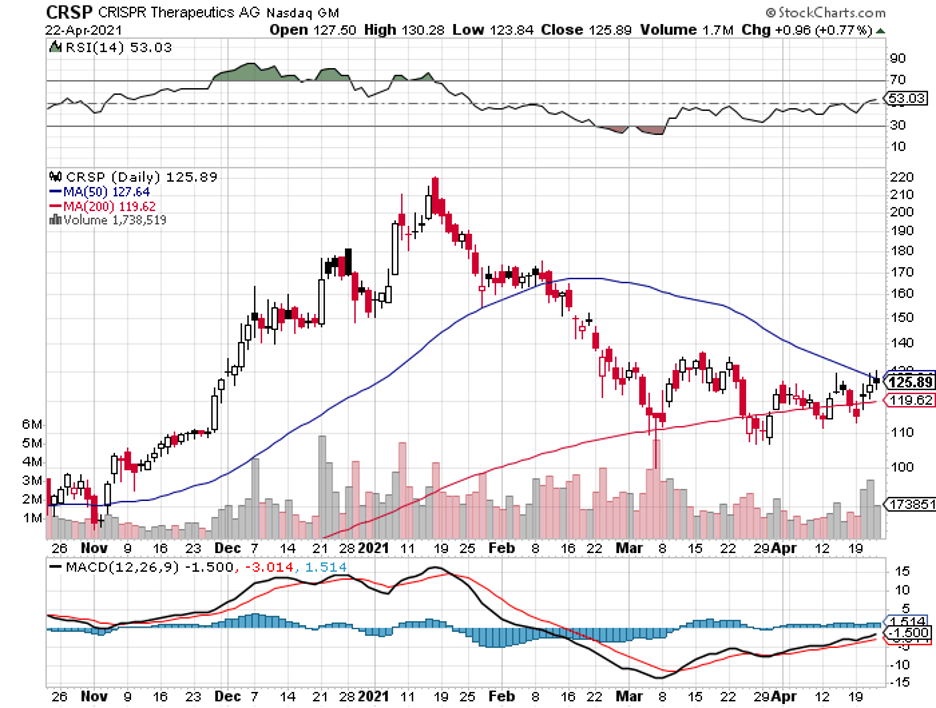
Global Market Comments
January 19, 2021
Fiat LuxFeatured Trade:
(WHY THERE’S ANOTHER DOUBLE IN CRISPR THERAPEUTICS)
(CRSP), (BLUE), (EDIT), (NVS), (GILD)
Occasionally, I discover a piece of research from one of my other Mad Hedge publications that is so important that I send it out to everyone immediately.
Recently, a piece from the Mad Hedge Biotech & Healthcare Letter is one of the instances. It makes the case and provides the numbers as to why Biotech & Healthcare will be one of two dominant sectors to follow for the next decade. It also is a key plank in my argument for a return of a new Golden Age and a second “Roaring Twenties.”
Here it is.
Biotech investors, take note: 2019 was a great year for the industry, but the best is yet to come.
In the final three months of 2019, the biotech sector grew by 32% -- notably outpacing the pharmaceutical industry, which only recorded a 9.5% gain.
However, the biotechnology sector is estimated to grow substantially in 2021 and reach over $775 billion in revenue by 2024 as more and more treatments for previously incurable diseases get discovered.
Looking at all the progress in the biotechnology space, this could even be the year we’d finally discover the cure to many life-threatening and debilitating conditions like cancer and Alzheimer’s disease.
With all these technological advancements, two revolutionary tools have been overhauling the entire biotechnology and healthcare industry from the ground up: precision medicine and CRISPR. Actually, the impressive growth of the biotechnology industry has been largely attributed to the excitement generated by the gene-editing sector.
While the majority of companies concentrating on the human genome are still in the research phase, the growth of this industry is undeniable.
Here’s tangible proof.
Just 20 years ago, reading all the DNA of a single person cost approximately $3 billion. Now, this price is down to only $1,000. In the future, this number will go even lower at $100. There are now gigantic factories in China sequencing DNA for companies like Ancestry.com and 23andMe.
This is just one example of how the biotechnology industry has grown by leaps and bounds. It’s also the reason behind the surge of CRISPR shares.
In effect, the specialists in this niche, including Crispr Therapeutics (CRSP), Bluebird Bio (BLUE), and Editas Medicine (EDIT), are amplifying their efforts.
Among the specialist companies, CRISPR Therapeutics is considered as one of the frontrunners -- if not the top stock. This is because compared to its rivals, which are still in preclinical phases of development, CRISPR Therapeutics already has two drugs going through Phase 1 trials: CTX001 and CTX110.
The promising results of the company’s research resulted in a 113% rise in shares last year, with the bulk of the surge starting in October. In fact, CRISPR Therapeutics’ performance had been so impressive that its market cap reached $3.4 billion.
CTX001 is created to target patients suffering from genetic blood disorders, specifically sickle-cell disease and transfusion-dependent beta-thalassemia.
Meanwhile, CTX110 is a CAR-T treatment. The process involves the extraction of immune cells from the patient. These are then retrained and later re-introduced to the human body.
CRISPR Therapeutics’ CAR-T treatment is anticipated to be offered at a cheaper price compared to the other CAR-T therapies.
Both Novartis (NVS) and Gilead Sciences (GILD) are pursuing the same treatment. However, the cost of the therapy from the latter two is expected to reach as much as $475,000 for every patient annually.
Apart from CTX001 and CTX110, CRISPR Therapeutics has two more immunology candidates, currently dubbed CTX120 and CTX130.
If both phase trials succeed, these will bring massive home runs for CRISPR Therapeutics, especially since the cancer immunology market is expected to reach $127 billion by 2026. Over the next 10 years, this niche is estimated to reach $25 trillion in sales.
Among the gene-editing treatments under development today, CRISPR is projected to grow tenfold in the number of applications and potentially curing 89% of disease-causing genetic variations by 2026.
Taking this pace into consideration, the valuation for this market is expected to grow from $551 million in 2017 to reach roughly $3.1 billion by 2023 and $6 billion by 2025.
Meanwhile, precision medicine as a whole is estimated to show a significant jump from $48.6 billion in 2018 to $84.6 billion by 2024. In 2028, this market is expected to rake in $216 billion.
Hence, further success with CTX001 and CTX110 along with additional treatments in the drug pipeline would all but guarantee that Crispr Therapeutics could beat the market again in 2021.
To subscribe to the Mad Hedge Biotech & Healthcare Letter for a bargain $1,500 a year, please click here.
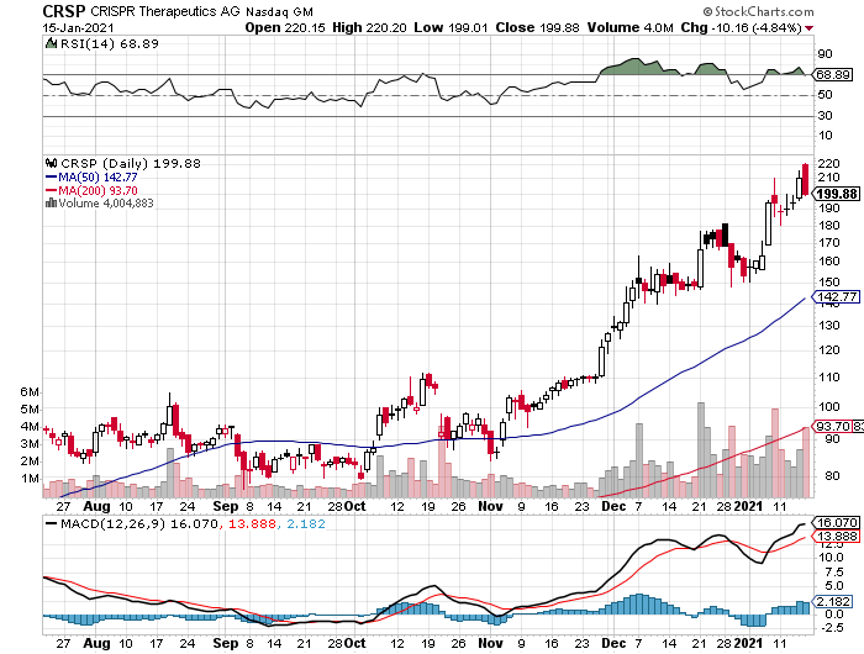
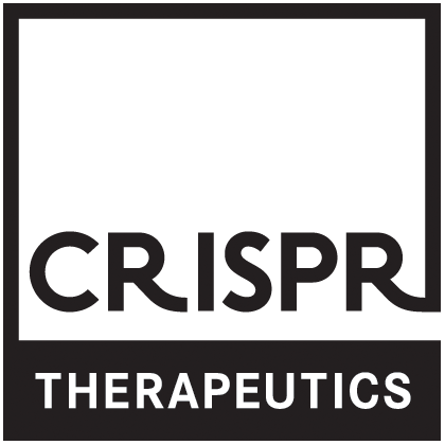

Mad Hedge Biotech & Healthcare Letter
September 10, 2020
Fiat Lux
Featured Trade:
(CAN CRISPR STOP THE SILENT KILLER?)
(CRSP), (VRTX), (EDIT), (NTLA)

Obesity has virtually tripled worldwide since 1975.
In 2019 alone, the World Health Organization classified 38 million children under 5 years old as overweight or obese.
More alarmingly, obesity has been dubbed as the “silent killer” because it is one of the leading factors that cause premature deaths.
In 2017, 4.7 million or 8% of global deaths were linked to this condition.
For context, the number of deaths caused by obesity is 4 times the fatality rate from road accidents and almost 5 times the number of those who died from HIV/AIDS.
Right now, 39% of adults across the globe are considered overweight and 13% are obese.
By 2030, nearly half the adult population of the United States is expected to be suffering from obesity.
Now, we might have the answer to this “silent killer:” CRISPR gene editing.
A recent Harvard study showed that CRISPR gene editing can be used to engineer cells to avoid weight gain and even potentially stop the onset of obesity-related diseases like diabetes.
The solution is straightforward.
The scientists will convert the body’s white fat, which is the “bad fat,” into brown fat or the "good fat.”
Brown fat is known as the healthy fat because it produces heat for the body by burning calories. Meanwhile, white fat tends to build up and leads to obesity.
Through CRISPR gene editing, the white fat is transformed into brown fat. This will then be burned by the body and used as an energy source, which can also result in weight loss.
So far, the technology proved to be successful in mice which were put on a high-fat diet.
What CRISPR targets is a gene for a protein called UCP1, which is distinctly found in brown fat.
The function of UCP1 is to turn chemical energy into heat.
Using the UCP1, the researchers created cells that closely resembled brown fat cells. These are called human brown-like cells or HUMBLE cells.
The manufactured HUMBLE cells are then transplanted into the mice with weakened immune systems. These mice were also fed with a high-fat diet.
Upon observation, they found that the modified cells actively helped in preventing the progression of obesity in mice and even showed improvements in the metabolic function of the animals.
Over the course of 12 weeks, the mice given white fat cells continued to gain weight while those transplanted with the HUMBLE cells showed weight loss. The latter also showed higher sensitivity to insulin, indicating that they could be protected against diabetes.
This is where it gets interesting because the technique can ultimately lead to cell therapies not only for obesity but also other metabolic disorders.
In the future, the process could evolve into something as convenient as removing a small amount of a patient’s white fat and having that engineered into brown-like fat and re-implanted to the same person’s body.
Apart from that, the HUMBLE cells also appear to send a chemical trigger to the existing brown fat stored in the mice’s own bodies, stimulating them to burn more energy.
This means that a simpler treatment method could be explored in which the experts could mimic the signal to activate the patient’s own brown fat. This will no longer require re-engineering the white fat and re-implanting it, making the entire treatment extremely straightforward.
The release of this study has profound implications to the total available market for CRISPR gene editing technology.
In the US alone, over 34 million are suffering from diabetes. The medical spending and loss of work wages linked to this is valued at roughly $327 billion annually.
If this technology proves to be effective in boosting a patient’s insulin sensitivity, then it could open an exponentially huge market.
Aside from diabetes, obesity is also considered a major risk factor in certain types of cancer, fatty liver and kidney disease, osteoarthritis, and even pregnancy problems.
This study is another example of how gene editing can be utilized to find treatments for untreatable conditions in the past years.
With this groundbreaking potential, it is no wonder investors are lining up to get their hands in biotechnology stocks in the gene editing sector.
The most widely known gene editing stock is CRISPR Therapeutics (CRSP).
With a market capitalization of $5.72 billion, this company is the only one in its field with actual treatments set for launch in the market soon.
One is a rare genetic disease treatment called CTX-001. Every year, about 60,000 people are born with this condition, causing anemia, lifelong pain, and early death. The other treatment is CTX-100, which is geared towards cancer patients.
Compared to its competitors like Editas Medicine (EDIT), which has a market capitalization of $1.82 billion, and Intellia Therapeutics (NTLA) with $1.03 billion, CRSP has a financial runway that can be reassuring to its investors.
CRSP also has minimal debt and a beneficial partnership with healthcare giant Vertex Pharmaceuticals (VRTX). This makes it one of the most attractive gene editing stocks out today.
Nonetheless, buying early stage companies, especially in the biotechnology sector, can be like oil wildcatting back in the 1930s. The key is to spread your bets broad enough to boost your chances of finding a gusher.
If this CRISPR gene editing technology works to treat obesity and even diabetes, then it could revolutionize the medical field.
While it’s still wise to exercise caution when investing in gene editing stocks, this technology undoubtedly embodies how the future of medicine looks like.
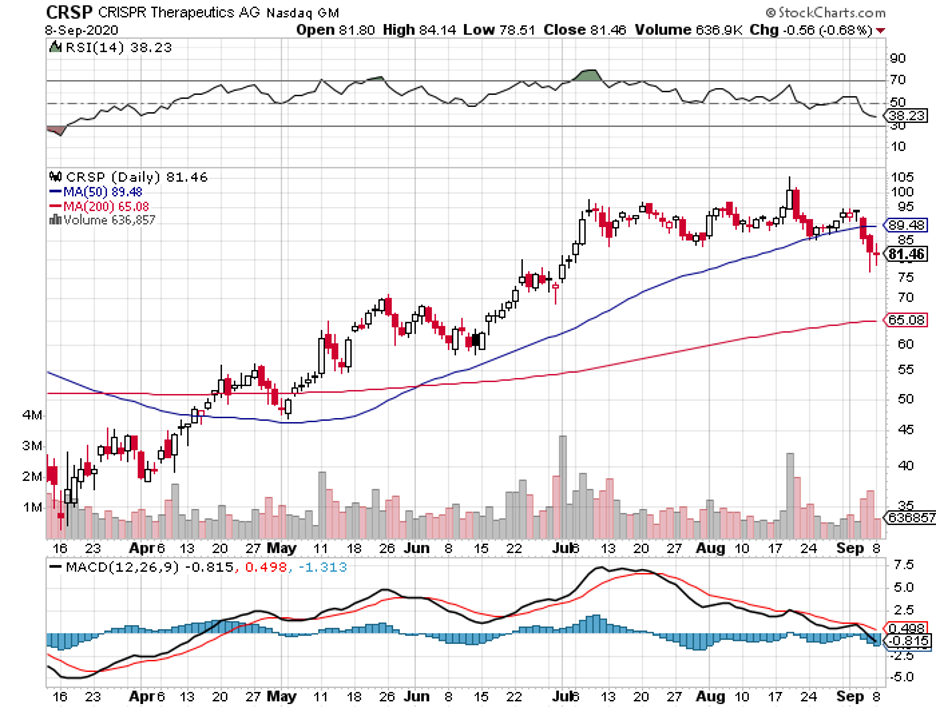
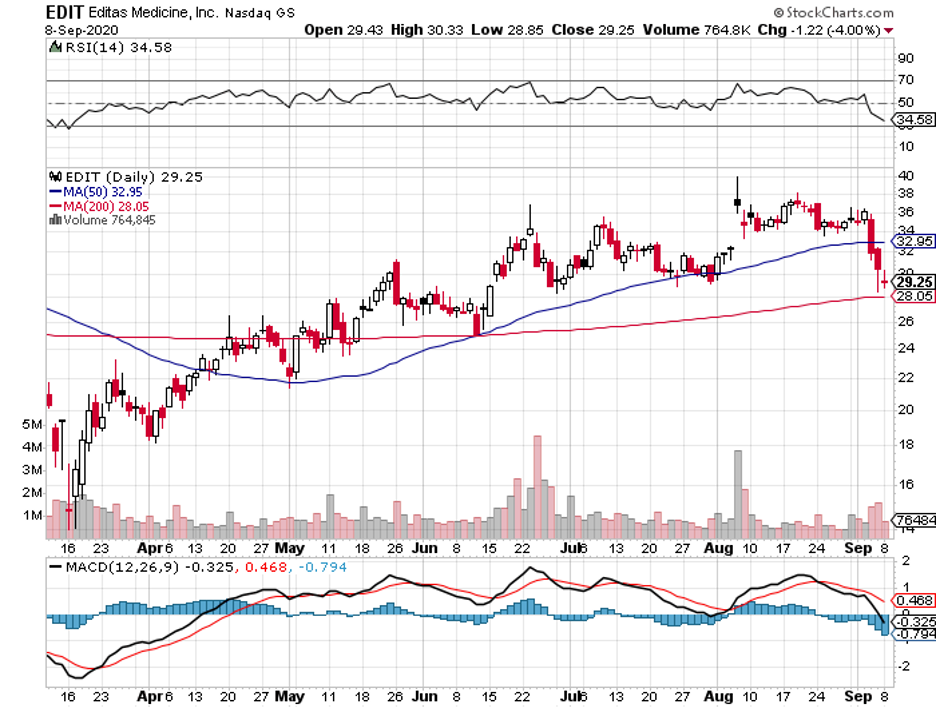
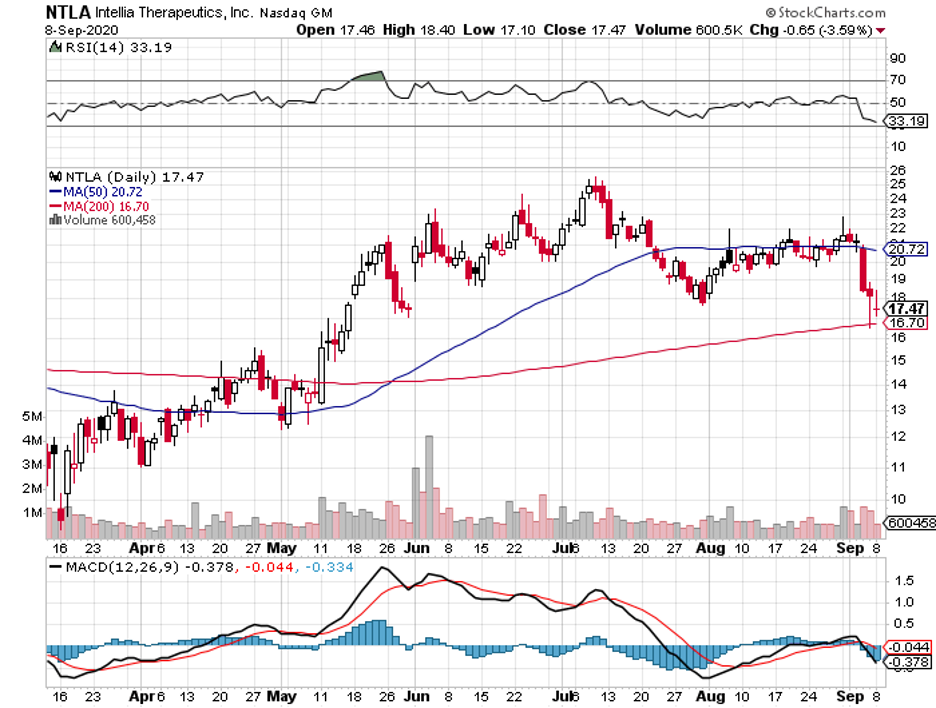
Mad Hedge Biotech & Healthcare Letter
August 27, 2020
Fiat Lux
Featured Trade:
(THE FUTURE OF GENE-EDITING TECHNOLOGY)
(CRSP), (VRTX), (BAYRY), (NTLA), (NVS), (EDIT), (BMY)

There are wise investments, and there are excellent investments.
CRISPR Therapeutics (CRSP) has been proving to qualify in the latter category.
In fact, the company is considered one of the best biotechnology stocks to own during these turbulent times. It is estimated to dominate the gene-editing therapy market, which will reach roughly $11.2 billion in worth by 2025.
Four years ago, CRISPR Therapeutics stock was trading at $14.09. Today, each share is worth $90.35.
This means that CRISPR Therapeutics biotechnology company has been trading for 540% more than its value since it went public in 2016.
This is a remarkable pace for a biotechnology stock, with CRISPR Therapeutics raking in $289 million in trailing 12-month revenue thanks to strategic collaborations.
It even has a decent $890 million stored in cash, with the company reporting a 16% profit margin despite not having any treatment or drug available in the market yet.
More importantly, CRISPR Therapeutics holds a novel position of being under absolutely zero pressure to push a product out the door.
Nonetheless, the investor confidence in CRISPR Therapeutics relies heavily on the company’s leading position in the groundbreaking world of gene-altering treatments.
Basically, the company specializes in creating and developing therapies for genetic diseases with either no cure available or require frequent transfusions.
Looking at the results of the recent tests on the company’s pipeline candidates, CRISPR Therapeutics is projected to transform into a household name in the next five to 10 years.
CRISPR Therapeutics has five cell therapy candidates in the clinical stage. Three of these target immuno-oncology, while the two are designed for genetic blood disorders like beta-thalassemia sickle cell disease.
Among the five, the most advanced is CRISPR Therapeutics’ collaborative work with Vertex Pharmaceuticals (VRTX) on beta-thalassemia therapy CTX001.
This candidate received a fast-track designation from the FDA, with CRISPR Therapeutics releasing promising preliminary results recently.
However, it is another Vertex collaboration drug that actually yielded CRISPR Therapeutics $25 million at the beginning of 2020.
The drug, which is developed to treat muscular dystrophy disorder, is expected to account for approximately $800 million in future milestone payments in the next few years.
Although the genetic blood disorder programs are raking in millions these days, CRISPR Therapeutics’ cancer treatment pipeline offers an even greater potential in terms of stable revenue streams.
The company is utilizing a gene-editing platform, called CRISPR/Cas9, to create “off the shelf” novel chimeric receptor (CAR) T-cells.
If successful, then CRISPR Therapeutics can use a single batch to treat a broad group of cancer patients.
This is groundbreaking because the typical way involves harvesting T-cells from the patients, tailor-fitting the therapies, then re-introducing the cells to the body.
With this technology, CRISPR Therapeutics can easily cover more markets and offer regular treatments for patients within shorter intervals.
That’s why it comes as no surprise that a major biotechnology player like Bayer (BAYR) reached out to the smaller company for a collaboration.
The CAR T-cell market is projected to hit $8.4 billion by 2027, with an estimated compound annual growth rate of roughly 15%.
Specifically, CRISPR Therapeutics expects this product to become a leader in the solid tumor cancer therapy space, pegged to reach $425 billion by 2027.
However, it is not only CRISPR Therapeutics that is widely known in the gene-editing sector.
To date, the company has two close competitors: Intellia Therapeutics (NTLA), which has a strategic partnership with Novartis (NVS), and Editas Medicine (EDIT), which is working alongside Bristol Myers-Squibb (BMY).
Both are also using the CRISPR/Cas9 technology to come up with treatments.
Although Intellia Therapeutics and Editas went public the same year as CRISPR Therapeutics, neither has performed quite as well.
For perspective, CRISPR Therapeutics currently has a market capitalization of $6.3 billion. In comparison, Intellia Therapeutics has $1.13 billion while Editas Medicine has $2.13 billion.
Keep in mind though that clinical-stage companies, particularly in the biotechnology sector, are inherently risky plays.
Among the companies in the space, CRISPR Therapeutics is emerging to be a solid bet not only from a cash perspective but also based on its strong pipeline and profitable collaborations.
Overall, CRISPR Therapeutics is still considered a high-risk option.
Hence, the safest way to invest is to build a carefully hedged portfolio filled with well-researched gene-editing stocks. This will minimize your risks and guarantee your exposure to the upside in case any of your chosen biotechnology companies makes it to the market with a groundbreaking therapy.
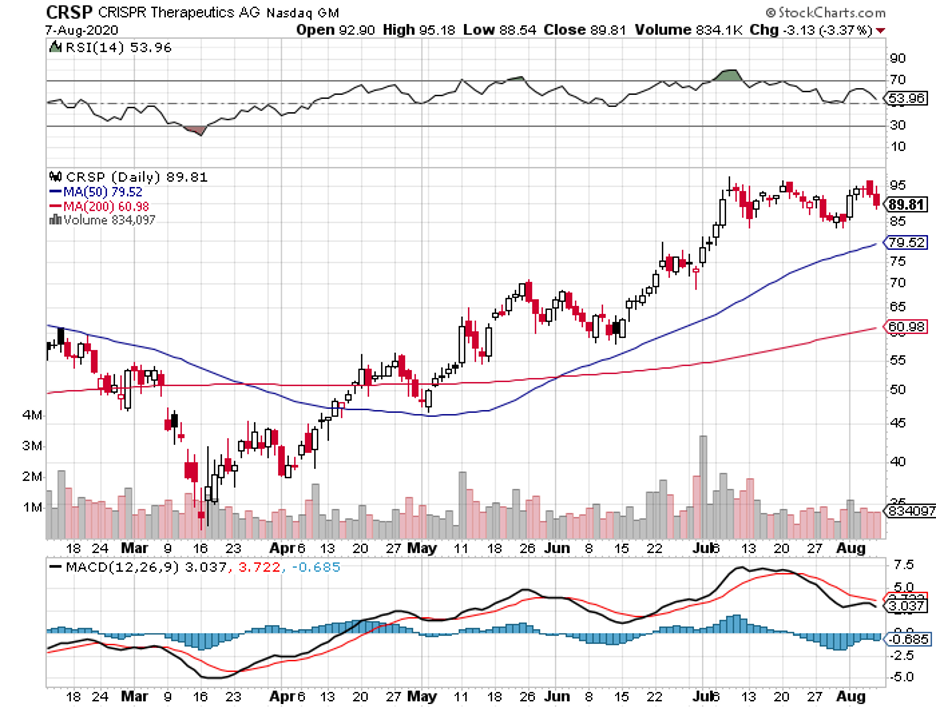
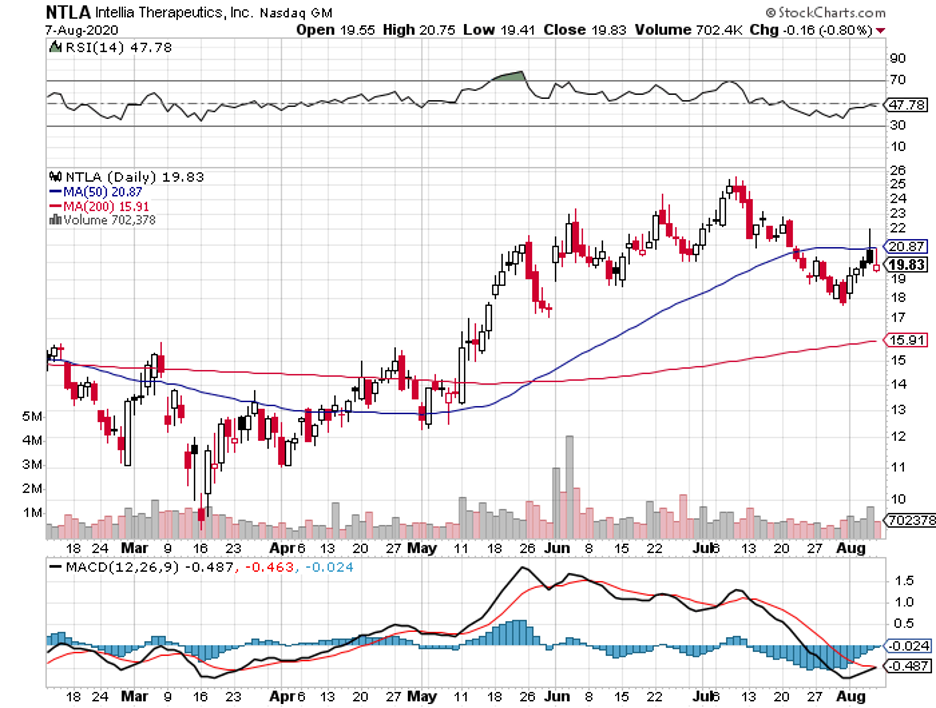
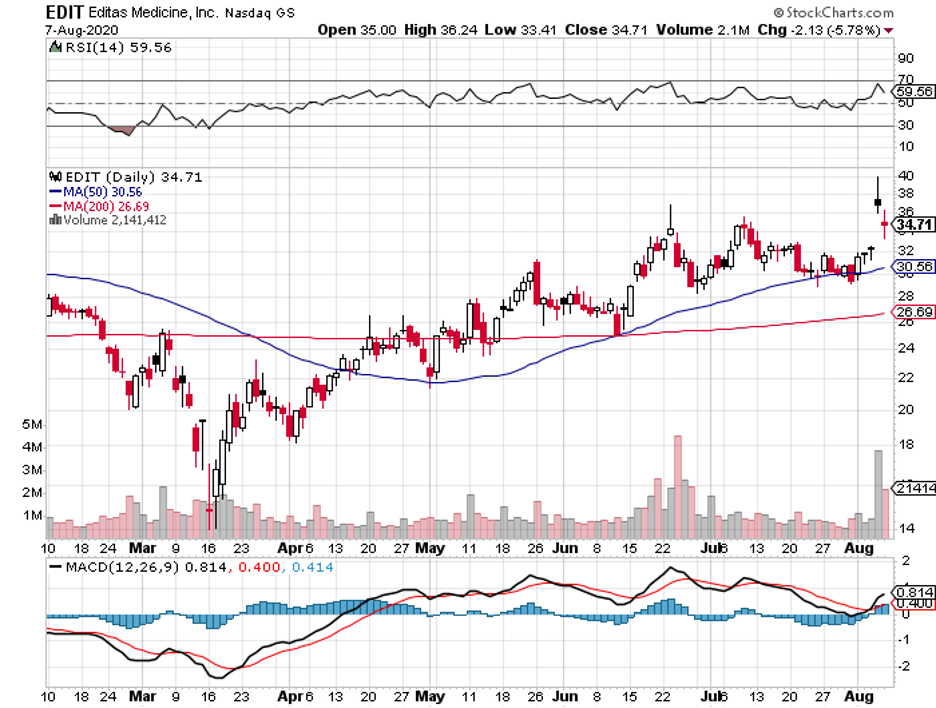
Global Market Comments
January 22, 2020
Fiat Lux
Featured Trade:
(LAST CHANCE TO ATTEND THE TUESDAY, FEBRUARY 4 SYDNEY, AUSTRALIA STRATEGY LUNCHEON)
(WHY THERE’S ANOTHER DOUBLE IN CRISPR THERAPEUTICS)
(CRSP), (BLUE), (EDIT), (NVS), (GILD)

Occasionally, I discover a piece of research from one of my other Mad Hedge publications that is so important that I send it out to everyone immediately.
Today piece from the Mad Hedge Biotech & Health Care Letter is one of the instances. It makes the case and provides the numbers as to why Biotech & Health Care will be one of two dominant sector to follow for the next decade. It also is a key plank in my argument for a return of a new Golden Age and a second “Roaring Twenties.”
Here it is.
Biotech investors, take note: 2019 was a great year for the industry, but the best is yet to come.
In the final three months of 2019, the biotech sector grew by 32% -- notably outpacing the pharmaceutical industry, which only recorded a 9.5% gain.
However, the biotechnology sector is estimated to grow substantially in 2020, and reach over $775 billion in revenue by 2024 as more and more treatments for previously incurable diseases get discovered.
Looking at all the progress in the biotechnology space, this could even be the year we’d finally discover the cure to many life-threatening and debilitating conditions like cancer and Alzheimer’s disease.
With all these technological advancements, two revolutionary tools have been overhauling the entire biotechnology and healthcare industry from the ground up: precision medicine and CRISPR. Actually, the impressive growth of the biotechnology industry has been largely attributed to the excitement generated by the gene-editing sector.
While the majority of companies concentrating on the human genome are still in the research phase, the growth of this industry is undeniable.
Here’s tangible proof.
Just 20 years ago, reading all the DNA of a single person cost approximately $3 billion. Now, this price is down to only $1,000. In the future, this number will go even lower at $100. There are now gigantic factories in China sequencing DNA for companies like Ancestry.com and 23andMe.
This is just one example of how the biotechnology industry has grown by leaps and bounds. It’s also the reason behind the surge of CRISPR shares.
In effect, the specialists in this niche, including Crispr Therapeutics (CRSP), Bluebird Bio (BLUE), and Editas Medicine (EDIT), are amplifying their efforts in 2020.
Among the specialist companies, CRISPR Therapeutics is considered as one of the frontrunners -- if not the top stock. This is because compared to its rivals, which are still in preclinical phases of development, CRISPR Therapeutics’ already has two drugs going through Phase 1 trials: CTX001 and CTX110.
The promising results of the company’s research resulted in a 113% rise in shares last year, with the bulk of the surge starting in October. In fact, CRISPR Therapeutics’ performance had been so impressive that its market cap reached $3.4 billion.
CTX001 is created to target patients suffering from genetic blood disorders, specifically sickle-cell disease and transfusion-dependent beta-thalassemia.
Meanwhile, CTX110 is a CAR-T treatment. The process involves the extraction of immune cells from the patient. These are then retrained and later re-introduced to the human body.
CRISPR Therapeutics’ CAR-T treatment is anticipated to be offered at a cheaper price compared to the other CAR-T therapies.
Both Novartis (NVS) and Gilead Sciences (GILD) are pursuing the same treatment. However, the cost of the therapy from the latter two is expected to reach as much as $475,000 for every patient annually.
Apart from CTX001 and CTX110, CRISPR Therapeutics has two more immunology candidates, currently dubbed CTX120 and CTX130.
If both phase trials succeed, these will bring massive home runs for CRISPR Therapeutics, especially since the cancer immunology market is expected to reach $127 billion by 2026. Over the next 10 years, this niche is estimated to reach $25 trillion in sales.
Among the gene-editing treatments under development today, CRISPR is projected to grow tenfold in the number of applications and potentially curing 89% of disease-causing genetic variations by 2026.
Taking this pace into consideration, the valuation for this market is expected to grow from $551 million in 2017 to reach roughly $3.1 billion by 2023 and $6 billion by 2025.
Meanwhile, precision medicine as a whole is estimated to show a significant jump from $48.6 billion in 2018 to $84.6 billion by 2024. In 2028, this market is expected to rake in $216 billion.
Hence, further success with CTX001 and CTX110 along with additional treatments in the drug pipeline would all but guarantee that Crispr Therapeutics could beat the market again in 2020.
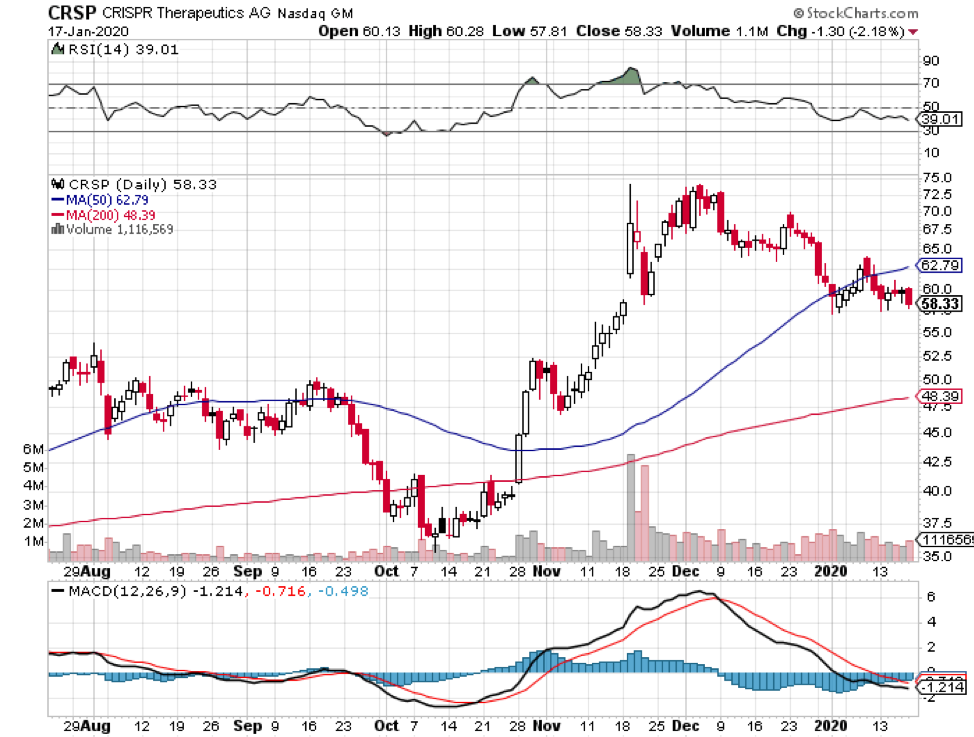
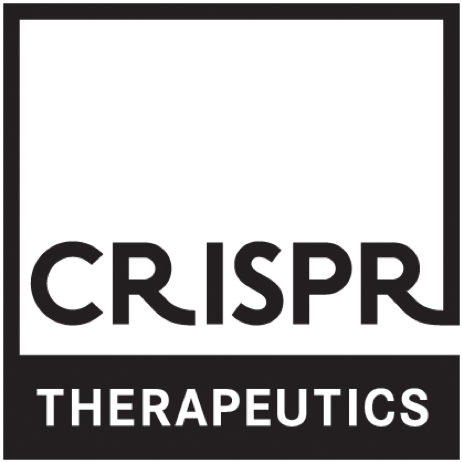

Legal Disclaimer
There is a very high degree of risk involved in trading. Past results are not indicative of future returns. MadHedgeFundTrader.com and all individuals affiliated with this site assume no responsibilities for your trading and investment results. The indicators, strategies, columns, articles and all other features are for educational purposes only and should not be construed as investment advice. Information for futures trading observations are obtained from sources believed to be reliable, but we do not warrant its completeness or accuracy, or warrant any results from the use of the information. Your use of the trading observations is entirely at your own risk and it is your sole responsibility to evaluate the accuracy, completeness and usefulness of the information. You must assess the risk of any trade with your broker and make your own independent decisions regarding any securities mentioned herein. Affiliates of MadHedgeFundTrader.com may have a position or effect transactions in the securities described herein (or options thereon) and/or otherwise employ trading strategies that may be consistent or inconsistent with the provided strategies.
This site uses cookies. By continuing to browse the site, you are agreeing to our use of cookies.
OKLearn moreWe may request cookies to be set on your device. We use cookies to let us know when you visit our websites, how you interact with us, to enrich your user experience, and to customize your relationship with our website.
Click on the different category headings to find out more. You can also change some of your preferences. Note that blocking some types of cookies may impact your experience on our websites and the services we are able to offer.
These cookies are strictly necessary to provide you with services available through our website and to use some of its features.
Because these cookies are strictly necessary to deliver the website, refuseing them will have impact how our site functions. You always can block or delete cookies by changing your browser settings and force blocking all cookies on this website. But this will always prompt you to accept/refuse cookies when revisiting our site.
We fully respect if you want to refuse cookies but to avoid asking you again and again kindly allow us to store a cookie for that. You are free to opt out any time or opt in for other cookies to get a better experience. If you refuse cookies we will remove all set cookies in our domain.
We provide you with a list of stored cookies on your computer in our domain so you can check what we stored. Due to security reasons we are not able to show or modify cookies from other domains. You can check these in your browser security settings.
These cookies collect information that is used either in aggregate form to help us understand how our website is being used or how effective our marketing campaigns are, or to help us customize our website and application for you in order to enhance your experience.
If you do not want that we track your visist to our site you can disable tracking in your browser here:
We also use different external services like Google Webfonts, Google Maps, and external Video providers. Since these providers may collect personal data like your IP address we allow you to block them here. Please be aware that this might heavily reduce the functionality and appearance of our site. Changes will take effect once you reload the page.
Google Webfont Settings:
Google Map Settings:
Vimeo and Youtube video embeds:
